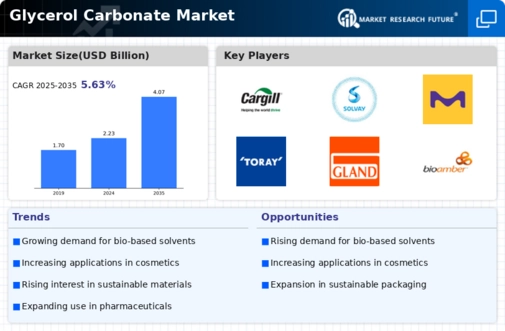Regulatory Support
Regulatory support plays a crucial role in shaping the Glycerol Carbonate Market. Governments worldwide are implementing stringent regulations aimed at reducing the environmental impact of chemical products. This regulatory landscape encourages the adoption of glycerol carbonate, which is recognized for its lower toxicity and environmental footprint compared to traditional solvents. The market is expected to benefit from these regulations, as they create a favorable environment for the development and commercialization of glycerol carbonate-based products. Furthermore, incentives for using bio-based materials are likely to enhance market growth. As industries comply with these regulations, the demand for glycerol carbonate is anticipated to rise, positioning it as a key player in the transition towards greener alternatives in various sectors.
Sustainability Initiatives
The Glycerol Carbonate Market is experiencing a notable shift towards sustainability initiatives. As industries increasingly prioritize eco-friendly practices, glycerol carbonate, derived from renewable resources, aligns well with these objectives. The market is projected to grow at a compound annual growth rate of approximately 6% over the next five years, driven by the demand for sustainable solvents and additives. This growth is further supported by the increasing awareness of environmental issues among consumers and manufacturers alike. Companies are actively seeking alternatives to petroleum-based products, and glycerol carbonate serves as a viable option. The emphasis on reducing carbon footprints and enhancing product life cycles is likely to bolster the market, as glycerol carbonate is biodegradable and non-toxic, making it an attractive choice for various applications.
Technological Advancements
Technological advancements are playing a pivotal role in the evolution of the Glycerol Carbonate Market. Innovations in production processes and formulations are enhancing the efficiency and cost-effectiveness of glycerol carbonate manufacturing. Recent developments in green chemistry are enabling the synthesis of glycerol carbonate from glycerol, a byproduct of biodiesel production, thereby reducing waste and promoting sustainability. These advancements are expected to lower production costs and improve the overall quality of glycerol carbonate, making it more competitive in the market. Furthermore, ongoing research into new applications and formulations is likely to expand the market's reach. As technology continues to evolve, the glycerol carbonate market is poised for growth, driven by enhanced production methods and the introduction of novel applications across various industries.
Diverse Industrial Applications
The versatility of glycerol carbonate is a significant driver for the Glycerol Carbonate Market. Its diverse applications across multiple sectors, including pharmaceuticals, cosmetics, and food, contribute to its growing demand. In the pharmaceutical industry, glycerol carbonate is utilized as a solvent and excipient, enhancing drug formulation and delivery. The cosmetics sector employs glycerol carbonate for its moisturizing properties, making it a popular ingredient in skincare products. Additionally, the food industry recognizes glycerol carbonate as a safe additive, further expanding its market reach. The increasing trend towards multifunctional ingredients in product formulations is likely to propel the glycerol carbonate market, as manufacturers seek to optimize performance while adhering to safety standards. This broad applicability underscores the potential for sustained growth in the glycerol carbonate market.
Rising Demand for Bio-based Products
The rising demand for bio-based products is significantly influencing the Glycerol Carbonate Market. As consumers become more environmentally conscious, there is a marked shift towards products derived from renewable resources. Glycerol carbonate, being a bio-based compound, is well-positioned to meet this demand. The market is projected to witness a surge in growth, with estimates suggesting an increase in market size by over 20% in the next five years. This trend is driven by the increasing preference for sustainable alternatives in various applications, including personal care, cleaning agents, and industrial solvents. Manufacturers are responding to this shift by incorporating glycerol carbonate into their formulations, thereby enhancing their product offerings and aligning with consumer expectations for sustainability. The growing acceptance of bio-based products is likely to further solidify glycerol carbonate's position in the market.

















Leave a Comment